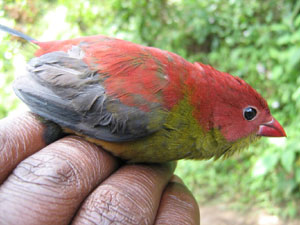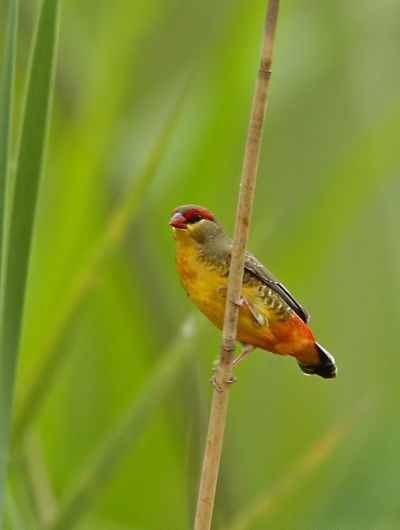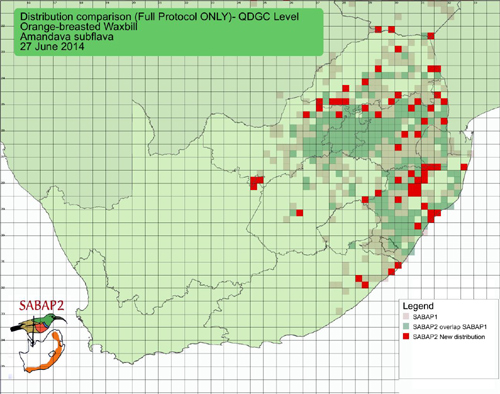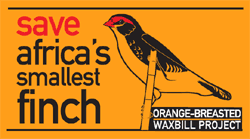|
||||||||
 |
||||||||
|
||||||||
R.F.C.G. News
|
Rare Finch Conservation Group (RFCG) adopts important
new conservation project RFCG to collaborate with BirdLife South Africa By Russell Kingston OAM and Eelco Meyjes After nine years of working on the threatened and elusive Shelley's
Crimsonwing finch ( Cryptospiza shelleyi ), that inhabits
the Bwindi Impenetrable Forest, Uganda the RFCG has decided to defer
its work on this particular species. The good news is that all the work done up in Uganda has not gone to waste. The RFCG has helped to raise the conservation profile both within Uganda and internationally of one of Africa's rarest and most threatened finches. The field work study that was kindly sponsored by the Hans Hoheisen Trust and completed in 2010 has been used by BirdLife International, Nature Uganda, Uganda Wildlife Authority and various other interested conservation organisations. While the IUCN Red Data lists the Shelley's Crimsonwing species as Vulnerable ( 2,000 to 10,000 birds ) there still are only two known photographs of the bird in the world. The first was sourced off the internet in 2008 from www.gorilla.org and the second photo was recently sent to the RFCG by Colin Jackson, from Kenya. Colin Jackson netted the bird whilst on a museum field expedition to primarily survey gorillas in the DRC back in 1997- ( see the world's second Shelley's Crimsonwing photograph and full story on the RFCG blog 7 July http://rarefinch.wordpress.com). Over the next couple of months, now with the help of BirdLife South Africa , more birders and twitchers in South Africa will be made aware of the rarity of the Shelley's Crimsonwing. Hopefully more birders will start to look for this rare finch when they travel to that magnificent part of Africa on their birding safaris.
Once the RFCG made the strategic decision to look for a finch conservation
project, preferably within the borders of South Africa, it was decided
to approach the best possible experts available in the country for
their professional advice. BirdLife South Africa , The South African
National Biodiversity Institute and the Fitzpatrick Institute at
the University of Cape Town were all consulted. Fortunately all
three organisations work very closely together and the Orange-breasted
waxbill ( Amandava subflava ) was identified as the finch
that now needs conservation help. Photo Chris Krog
This is what Dr. Hanneline Smit-Robinson , Terrestrial Bird Conservation Manager at BirdLife South Africa, had to say about the species "ongoing field reports suggest that fewer of these finches are seen in some of their previous habitats. According to the Southern African Bird Atlas Project 2 (SABAP2) comparison map, the reporting rate of Orange-breasted Waxbill has drastically declined ". Visual : SABAP1 and 2 map
Figure 1: Map showing the distribution changes between SABAP1 and SABAP2 - taken from http://sabap2.adu.org.za/spp_summary.php?Spp=838§ion=2 Whilst the Orange-breasted Waxbill can be seen in many other parts of Africa, our focus will initially only be on the distribution of the species in South Africa. Through a citizen science project, the Southern African Bird Atlas Project, current distributions ( SABAP2 ). Data are collected in 5x5 minute grids ( called pentads ) and vetted before inclusion in the project ( see http://sabap2.adu.org.za/ ).These SABAP maps allow for excellent ongoing early warning signals on the conservation status for each bird species in South Africa. The Orange-breasted Waxbill is a wetland and grassland specialist. While at this stage it still is not listed as threatened, the possible decline in numbers and decline in range suggest further study is needed as part of one of BirdLife International's global programmes Keeping Common Birds Common. Dr. Hanneline Smit-Robinson goes on to say " The Orange-breasted
Waxbill will be a good flagship sentinel species for other grassland
and wetland specialists, endemics, threatened and or/common species."
Typical wetland habitats for the Orange-breasted Waxbill
Photo : Eelco Meyjes
The above species are listed in the updated 2014 Eskom Red Data book of Birds of South Africa, Lesotho and Swaziland. This will be the first project where the RFCG, which is a specialist avicultural group, will collaborate with BirdLife South Africa, one of the 124 global partners of BirdLife International. The work required will be divided into two Phases. Phase 1 will require extensive desktop analyses where population trends of the species need to be determined using the current data available such as ringing data, early atlas records, books, museum records, existing literature including data from newsletters, journals etc. from as far back as the 1940's. This data will help to illustrate the dramatic changes in distribution of the species over the years. All of the RFCG members will bring together our different skills to the desktop study which will last about one year. Skills ranging from scientific data capturing to public awareness and educational campaigns to both the avicultural as well as to the birder markets will be utilised. Once this is completed the range changes will be investigated using 10 identified areas where the Orange-breasted Waxbill used to be found versus 10 identified areas where the species still currently appears. The vegetation at each site will be described and surveyed , land clearing , urban expansion , industrial expansion, introduction of pest fauna and flora, introduction of spread of disease and parasites, air and water quality tests will be undertaken in a scientific manner. Academic involvement for this second phase will be included using either an MSc or PhD student through the Percy FitzPatrick Institute from the University of Cape Town. Point and transect counts will be done, and density estimates will be calculated in optimal habitats, to improve our current knowledge on the abundance of this species. Launch and Fundraising To help launch the project awareness and fundraising campaign Eelco
Meyjes , who is both a director of the Rare Finch Conservation Group
and member of BirdLife South Africa , in March and April last year
successfully rode an unsupported solo cycle ride from Cape Town,
South Africa to Victoria Falls in Zimbabwe, a distance of 3008 km
in a period of 44 days . 7 Of the days were rest days. Carrying
his own kit of 35 kg, excluding the weight of his daily water supply,
he cycled an average of just under 82km per ride day.
Eelco Meyjes at Victoria Falls. Rode a distance of 3008km . Photo : Lesanne Dunlop
For more info contact the RFCG secretary at editor@avitalk.co.za
or phone +27 (0)11 447 4828. The Rare Finch Conservation Group is
extremely proud to be collaborating with BirdLife South Africa on
this important new conservation project.
|
|||
Contact Rare Finch Conservation Group
e-mail: editor@avitalk.co.za | postal:
P.O.Box 782403, Sandton, 2146, South Africa
Copyright © 2006-2025 Rare Finch Conservation
Group in all materials not expressly attributed to another. All rights reserved.
Web Development www.simplywebs.co.za












